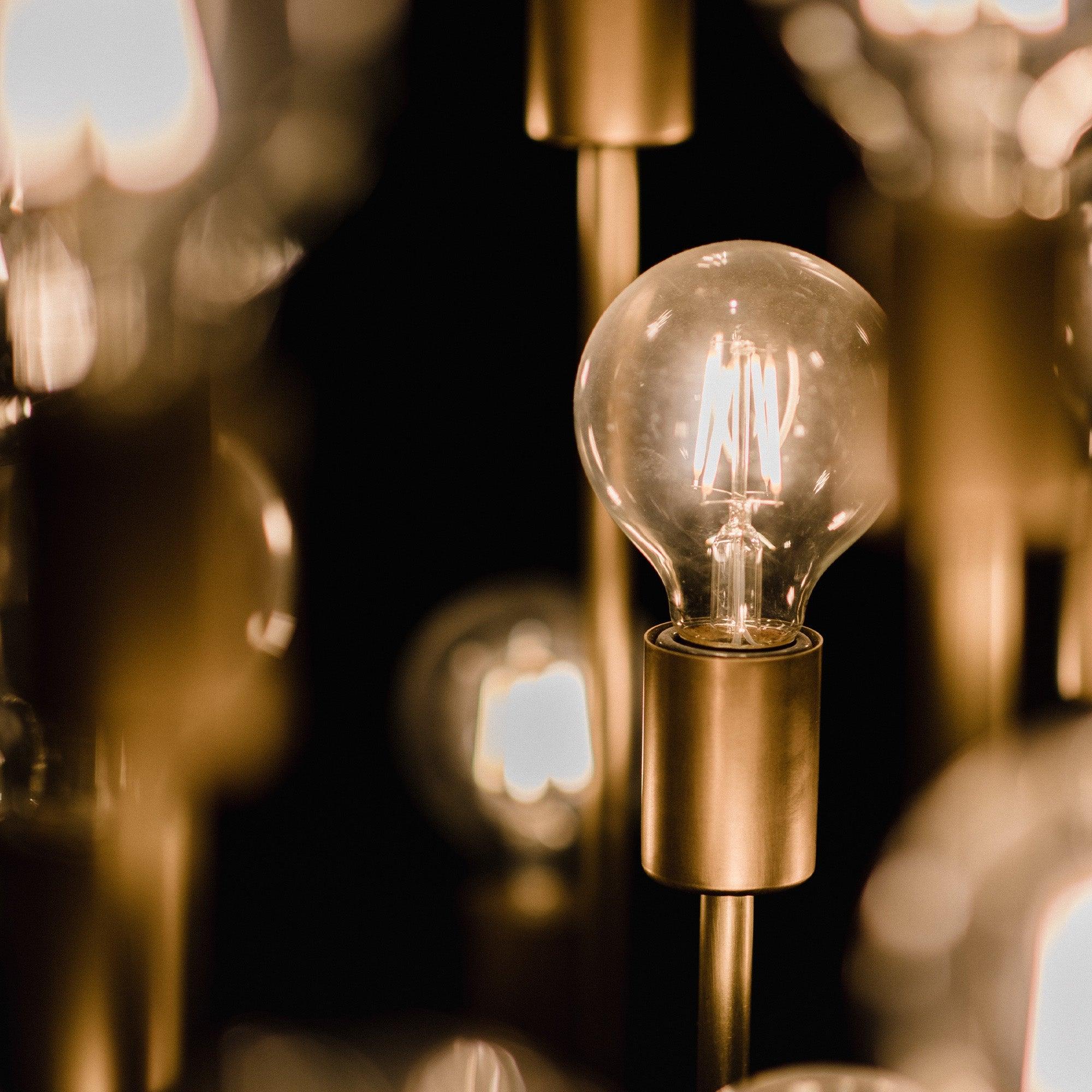
Choosing the right light bulb becomes much simpler when you can identify their shapes and sizes. Whether you’re upgrading your lighting or switching to LEDs for their benefits—like energy efficiency, longer lifespan, and better control—understanding light bulb codes can make all the difference. Light bulb sizes are especially important, as different fixtures require specific sizes and shapes to ensure proper fit and function.
Light bulbs are labeled with a combination of letters and numbers known as light bulb codes, which indicate their shape, features, and size. The letters typically describe the shape or a specific characteristic, while the numbers denote size, measured in millimeters or fractions of an inch.

Bulbs are shaped in various ways—such as conical, blunt-tip, or globe-shaped—to suit different applications. By decoding these codes, you’ll know if a bulb will fit your fixture and meet your lighting needs. Some codes also indicate special features, such as reflector type or unique bulb shapes, which can be important for specific lighting requirements.
For instance, each lighting application often requires a specific bulb shape to achieve the best results. The glass construction of bulbs can also affect their durability and appearance, making it an important factor to consider. Familiarity with these codes allows you to quickly determine which bulb fits your fixture. Alternatively, tools like a Universal Bulb Finder can simplify the selection process.
Here’s a Kastlite overview of common bulb groups, their codes, and typical uses:
Introduction to Lighting
Lighting is more than just a practical necessity—it’s a defining element of any space, shaping both ambiance and functionality. The right light bulbs can transform a room, enhance décor, and even improve energy efficiency.
With so many options available, from classic incandescent light bulbs to modern LED bulbs and energy-saving fluorescent light bulbs, navigating endless options can feel overwhelming. That’s why understanding light bulb shapes, sizes, and codes is essential.
In this guide, we’ll break down the different types of light bulbs and bulb shapes, helping you make informed choices for every lighting need, whether you’re updating a cozy living room or outfitting a commercial workspace.
A Group: A15, A19, A21, A25

Standard or Arbitrary (A) bulbs are the most common for household lighting, ideal for fixtures like ceiling lights, lamps, and porch lights. They are also commonly used in ceiling fans for both standard and decorative lighting.
- A15: Diameter of 1-7/8″ (15/8 inches)
- A19: Diameter of 2-3/8″ (19/8 inches), the most widely used light bulb size in residential settings.
- A21: Diameter of 2-5/8″ (21/8 inches)
- A25: Diameter of 3-1/8″ (25/8 inches)

Many A-type bulbs are available in dimmable versions, providing adjustable brightness for different environments.
G Group: G11, G14, G16/G50, G60, G25/G80, G30

Globe (G) bulbs have a round shape and are often used in chandeliers, kitchens, or bathroom vanities. G bulbs come in various sizes to fit different fixtures and preferences. G25 bulbs, measuring 25/8" in diameter, are particularly ideal for bathroom vanity lights. Spherical or rounded bulbs like G25, G30, and G40 are perfect for decorative fixtures and create a warm atmosphere.
- G11: Diameter (width at the widest point) of 1-3/8″ (11/8 inches)
- G14: Diameter (width at the widest point) of 1-3/4″ (14/8 inches)
- G16/G50: Diameter (width at the widest point) of 2″ (16/8 inches or 50mm)
- G60: Diameter (width at the widest point) of 2-3/8″ (60mm)
- G25/G80: Diameter (width at the widest point) of 3-9/64″ (80mm)
- G30: Diameter (width at the widest point) of 3-3/4″ (30/8 inches)

The G30 is the most common type and common type for residential applications, especially in bathroom fixtures and makeup vanities, due to its ideal width and versatile use.
B and C Groups: B10, C7, C9, C15, CA10

These bulbs mimic the shape of a candle flame. Variants include blunt-tip (B), conical (C), and conical angular (CA) bulbs; some candle bulbs feature a bent tip, which adds a decorative element ideal for ornate fixtures such as chandeliers, decorative strands, and holiday lights.
- B10/CA10: Diameter of 1-1/4″ (10/8 inches)
- C7: Diameter of 7/8″
- C9: Diameter of 1-1/8″
- C15: Diameter of 1-7/8″

BR Group: BR20/R20, BR30, BR40

Bulged Reflector (BR) bulbs, traditionally made with reflective interiors, diffuse light to minimize shadows. LED BR bulbs mimic this effect without requiring a reflector. They’re commonly used in recessed or track lighting. BR bulbs have a wider, more diffused beam spread, making them suitable for flood lighting. BR bulbs are also designed to fit into light housings and are used in similar applications such as display lighting and can lights. Additionally, BR bulbs provide wide, diffused light output with a gradual fade through frosted, clear, or patterned lenses.
- BR20/R20: Diameter of 2-1/2″ (20/8 inches)
- BR30: Diameter of 3-3/4″
- BR40: Diameter of 5″

PAR Group: PAR16, PAR20, PAR30, PAR36/AR111, PAR38

Parabolic Aluminized Reflector (PAR) bulbs focus light into spot or flood beams, making them perfect for outdoor lighting, track lights, and recessed fixtures. PAR bulbs are also ideal for large-scale lighting applications in sports arenas, parking garages, and retail stores due to their powerful illumination. To adjust the color of your light, you can use one of our lens filters, such as the KastLite Clear Acrylic Filter, available here.
This connects the PAR bulbs to the lens filters seamlessly while also promoting the product.
- PAR16: Diameter of 2″ (16/8 inches)
- PAR20: Diameter of 2-1/2″
- PAR30: Diameter of 3-3/4″
- PAR36/AR111: Diameter of 4-1/2″ (36/8 inches or 111mm)
- PAR38: Diameter of 4-3/4″

MR Group: MR11 and MR16

Multifaceted Reflector (MR) bulbs are small but powerful, often used in track or display lighting. Their faceted design creates precise, focused lighting. MR group bulbs emit a concentrated beam of directionally focused light. MR (Multifaceted Reflector) spotlights provide precise, high-intensity directional lighting. Customize your lighting color using one of our lens filters, such as the KastLite Clear Acrylic Filter, which you can find here.
- MR11: Diameter of 1-3/8″ (11/8 inches)
- MR16: Diameter of 2″

T Group: T7, T8, T10, T14

Tubular (T) bulbs are elongated and work in a variety of fixtures, from chandeliers to garage lights. These bulbs are also known as tube bulbs due to their cylindrical shape. Tubular (T) bulbs are available in various lengths and widths, primarily used for commercial and decorative applications. T-type (Tube) bulbs are traditionally used for fluorescent lighting in offices, garages, and kitchens.
- T7: Diameter of 7/8″ (the number refers to the width of the tube at its widest point; length is another important measurement for selecting the right bulb)
- T8: Diameter of 1″ (width of the tube)
- T10: Diameter of 1-1/4″ (width of the tube)
- T14: Diameter of 1-3/4″ (width of the tube)

T bulbs are available in a range of lengths and widths to suit different fixtures and applications, making them versatile for uses such as signage, office lighting, and industrial settings.
By understanding these shapes and sizes, you can confidently select the right light bulb for any project, ensuring both compatibility and optimal lighting performance.
Light Bulb Base
The light bulb base is a key factor in ensuring your bulb fits securely and functions properly in your chosen light fixture. Each light bulb base is identified by a code—usually a letter or series of letters followed by a number.
The letters indicate the type of base, while the number refers to the diameter of the base in millimeters. For example, an E26 base is a medium screw base commonly found in standard household fixtures, with a diameter of 26 mm. Light bulbs can have different base types, with Edison screw being the most common in American homes. Understanding light bulb base codes helps you avoid the frustration of buying bulbs that don’t fit your fixtures.
Common base types include screw bases (like E26 and E12), bayonet bases, bi-pin bases (often used in track lights and recessed lights), and wedge bases, which are popular in decorative lights and specialty applications. Each base type is designed for specific lighting scenarios, so always check the base code to ensure compatibility with your light fixtures.
Shapes and Sizes Variations
Light bulbs are available in a remarkable variety of shapes and sizes, each tailored to specific lighting applications and aesthetic preferences.
The most common light bulb shapes include A (arbitrary), B (blunt tip), C (candle flame), BR (bulged reflector), MR (multifaceted reflector), PAR (parabolic aluminized reflector), and G (globe). For example, B and C type bulbs mimic the elegant shape of a candle flame, making them perfect for chandeliers and decorative fixtures, while BR bulbs feature a bulged reflector ideal for wide, even light distribution.
The size of a light bulb is typically indicated by a number that represents the diameter of the bulb in eighths of an inch—so an A19 bulb has a diameter of 2.375 inches (19/8 inches). Understanding these different bulb shapes and sizes ensures you select the right bulb for your lighting needs, whether you’re looking for a slender candle bulb for a sconce or a robust reflector bulb for a recessed fixture.
Bulb Shape Considerations
Selecting the right light bulb shape is about more than just aesthetics—it’s about matching the bulb’s design to its intended use. Different bulb shapes are engineered for specific lighting effects and applications.
For instance, par bulbs with a parabolic aluminized reflector are commonly used in outdoor lighting and recessed lighting applications, delivering a focused, powerful beam ideal for highlighting architectural features or illuminating large areas. MR bulbs, with their multifaceted reflectors, are perfect for track lighting and decorative lighting, offering precise, directional light.
The choice of reflector material also plays a role: bulbs with a built-in reflector, like PAR and BR bulbs, provide targeted or diffused light, while other shapes may offer a softer glow.
By considering the unique features of each bulb shape, you can achieve the perfect balance of style and function for your space—whether you need dramatic accent lighting, practical task lighting, or a warm, inviting ambiance.
Conclusion
Understanding the wide array of light bulb shapes, sizes, and base types empowers you to confidently navigate endless options and find the perfect lighting solution for any project.
Whether you’re upgrading to energy-efficient LED bulbs, selecting decorative candle bulbs for a chandelier, or outfitting commercial spaces with specialized reflector bulbs, knowing how to decode light bulb codes and match shapes to applications ensures optimal performance and style.
Ready to transform your lighting? Shop all products at KastLite and discover high-quality, energy-efficient lighting and plastic solutions for every space.

